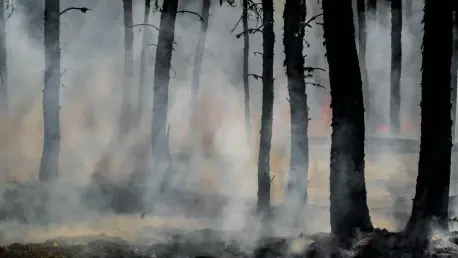In the rugged terrain of Lake County, California, a quiet but determined battle is being waged against the ever-present threat of wildfires, a force that has reshaped lives and landscapes with unrelenting ferocity over the past decade. With 70% of the region charred by flames, including the devastating 2015 Valley Fire that erased over 1,200 homes, the scars of destruction are both physical and emotional. These relentless disasters have transformed fear into action, spurring residents and local leaders to fortify their homes and neighborhoods against future blazes. From individual retrofits to sweeping community projects, the drive to mitigate risk is palpable. Yet, even as shovels turn earth and policies evolve, a persistent shadow looms—skyrocketing insurance costs that refuse to budge, leaving many to wonder if their hard-fought safety measures will ever yield financial relief. This tension between proactive resilience and systemic barriers paints a complex picture of a community striving to outpace nature’s wrath while grappling with economic realities.
Community Efforts and Wildfire Mitigation
Home Hardening and Neighborhood Resilience
The cornerstone of Lake County’s defense against wildfires lies in programs designed to protect homes from the ember showers that often ignite catastrophic losses. The Lake County Home Hardening Program stands as a testament to this mission, having already retrofitted over 30 homes with plans to reach 350 more. Simple yet effective upgrades—such as replacing flammable mulch with gravel, sealing attic vents with mesh screens, and covering gutters—target the vulnerabilities that flames exploit most. These efforts, often provided at no cost to homeowners through state and federal funding, aim to create a shield against the initial sparks that can turn a small fire into a neighborhood-wide inferno. For residents like Penny Sidhu of Kelseyville, who has evacuated three times to escape encroaching blazes, such changes offer a rare sense of security in an otherwise uncertain landscape.
Beyond individual properties, the program emphasizes a collective approach, targeting entire clusters of homes to foster what experts call a “resiliency effect.” This strategy hinges on the idea that a single fortified house is less effective if its neighbors remain vulnerable—fire spreads through proximity, after all. By hardening multiple homes in a neighborhood, the risk of a blaze jumping from one property to the next diminishes significantly. Supported by FEMA grants and local initiatives, this neighborhood-wide focus reflects a deeper understanding that safety is a shared responsibility. The sight of crews working block by block, installing fire-resistant materials, symbolizes a community refusing to be defined by past devastation, instead building a future where survival isn’t left to chance.
Large-Scale Protective Measures
On a broader scale, Lake County’s wildfire mitigation extends far beyond individual rooftops to encompass landscape-level interventions that safeguard entire communities. Clearing flammable vegetation, such as dry brush and overgrown trees, forms a critical buffer against advancing fires, reducing the fuel that can turn a spark into a raging disaster. These efforts, often spearheaded by local authorities with support from state programs like the California Wildfire Mitigation Program, prioritize high-risk zones where dense undergrowth meets residential areas. Every acre cleared represents a hard-won victory, a tangible step toward shrinking the window of opportunity for wildfires to gain traction. Such projects demand coordination and resources, yet they embody the region’s commitment to proactive defense over reactive despair.
Equally vital are the improvements to evacuation routes, which ensure that residents can escape danger swiftly when flames approach. Widening narrow roads, clearing overhanging branches, and marking clear paths out of vulnerable areas are not just logistical upgrades—they are lifelines. Leaders like Supervisor Jessica Pyska, who herself lost a home in the 2015 Valley Fire, advocate for a methodical, incremental approach, recognizing that while resources may be limited compared to wealthier neighboring regions, every small improvement counts. These large-scale measures, often funded through state and federal partnerships, underscore a collective resolve to not only withstand wildfires but to outmaneuver them, creating safer conditions for both current residents and future generations.
Insurance Challenges and Systemic Barriers
Rising Premiums and Policy Cancellations
Despite the tireless efforts to fortify Lake County against wildfires, the financial burden of insurance remains a crushing obstacle for many residents. Premiums have surged to staggering heights, with annual costs often reaching levels that strain even the most stable budgets. Compounding this issue, policy cancellations are rampant, ranking among the highest in the nation according to recent Senate Budget Committee findings. Homeowners find themselves abruptly dropped by insurers, left with few options beyond the state-run FAIR plan—a last resort that offers limited coverage at exorbitant rates. This relentless financial pressure transforms the pursuit of safety into a bitter trade-off, where investments in home protection are undermined by bills that seem disconnected from the risks being mitigated.
The impact of this insurance crisis ripples through the community, affecting far more than just monthly expenses. For many, the dream of homeownership or even maintaining a current property becomes a gamble against unpredictable costs. Real estate transactions falter as potential buyers, confronted with quotes as high as $10,000 per year, reconsider their plans or fail to secure mortgages. Realtors like Sandy Tucker witness deals collapse under the weight of these figures, a trend that stifles the local housing market and erodes economic stability. Small discounts of 5-10% offered by some insurers for individual home retrofits provide scant relief, especially when broader community efforts go unrecognized, leaving residents feeling trapped in a cycle of rising costs with little acknowledgment of their proactive steps.
Data Gaps and Industry Hesitation
A significant hurdle in aligning wildfire mitigation with insurance relief lies in the persistent data gaps that prevent insurers from fully assessing community-wide efforts. While individual home retrofits may earn modest premium reductions under California regulations, larger initiatives—such as vegetation clearance or enhanced evacuation infrastructure—often fall outside the scope of what insurance models can quantify. The absence of verified, comprehensive data on these neighborhood-level projects means that insurers lack the tools to adjust rates based on reduced collective risk. This disconnect fosters frustration among residents and officials who see their labor-intensive safety measures overlooked, creating a perception that their diligence yields no tangible reward in the eyes of the industry.
Hope emerges in the form of innovative solutions like the WUI Data Commons, a proposed database designed to aggregate detailed information on local mitigation projects for insurer access. Spearheaded by experts like Nancy Watkins from Milliman, this tool aims to bridge the information divide, offering a transparent view of how community actions lower wildfire risks. However, significant challenges remain, including protecting consumer privacy and navigating the competitive dynamics of the insurance sector, where data-sharing is not always a priority. Industry representatives, such as Robert Gordon of the American Property and Casualty Insurance Association, caution that even with better data, broader economic pressures like inflation, labor costs, and climate change may limit reductions in premiums. This uncertainty leaves Lake County’s future in limbo, as technological promise collides with systemic inertia.
Economic and Emotional Toll
The escalating insurance crisis in Lake County exacts a toll that extends beyond mere finances, cutting deep into the emotional fabric of the community. Homeowners grapple with the constant anxiety of unaffordable coverage or the stark choice to go uninsured altogether, a decision that Supervisor Jessica Pyska notes is becoming alarmingly common. This precarious situation heightens the stress of living in a wildfire-prone area, where the threat of losing everything to flames is compounded by the fear of financial ruin. For individuals like Penny Sidhu, the relief of a retrofitted home clashes with the ongoing dread of policy cancellations, creating a duality of gratitude and uncertainty that defines daily life for many in the region.
Moreover, the broader economic implications weigh heavily on Lake County’s vitality. As high insurance costs deter home purchases and disrupt real estate stability, the community faces a slow erosion of growth and opportunity. Families hesitate to settle in an area where financial security feels out of reach, while existing residents question how long they can endure the mounting pressures. The personal stories of loss—echoed by leaders like Pyska who have rebuilt after disaster—highlight a resilience that is tested anew by systemic barriers. The emotional burden of preparing for wildfires, only to be met with indifferent insurance practices, underscores a profound need for alignment between community action and industry response, a harmony that remains frustratingly elusive.
Looking Ahead to Potential Solutions
Reflecting on the past struggles of Lake County, it’s clear that the fight against wildfires and the accompanying insurance challenges demanded both grit and innovation from a community repeatedly tested by nature’s fury. Residents and officials alike poured energy into retrofitting homes and reshaping landscapes, driven by the memory of blazes that consumed entire neighborhoods. Their determination was evident in every cleared patch of brush and every fortified vent, a collective stand against a recurring threat. Yet, the indifference of rising premiums and policy cancellations often overshadowed these achievements, leaving a bitter aftertaste to hard-earned progress.
Moving forward, actionable steps emerged as critical to breaking this deadlock. Advocating for policy reforms that mandate insurers to account for community-wide mitigation efforts became a priority, as did supporting tools like the WUI Data Commons to ensure data transparency. Encouraging collaboration between state agencies, local leaders, and the insurance industry offered a path to integrate risk reduction into pricing models. Additionally, expanding funding for mitigation programs through federal and state grants could ease the burden on residents, allowing more homes to be hardened without sacrificing financial stability. These strategies, though complex, pointed toward a future where safety and affordability might finally align, honoring the resilience that defined Lake County’s response to adversity.









